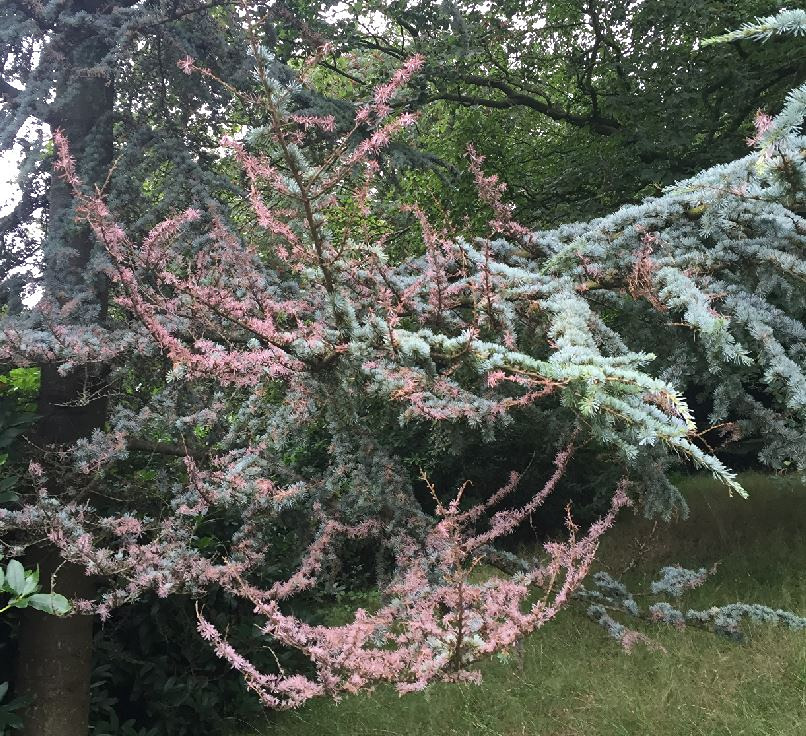Tree Pests & Diseases
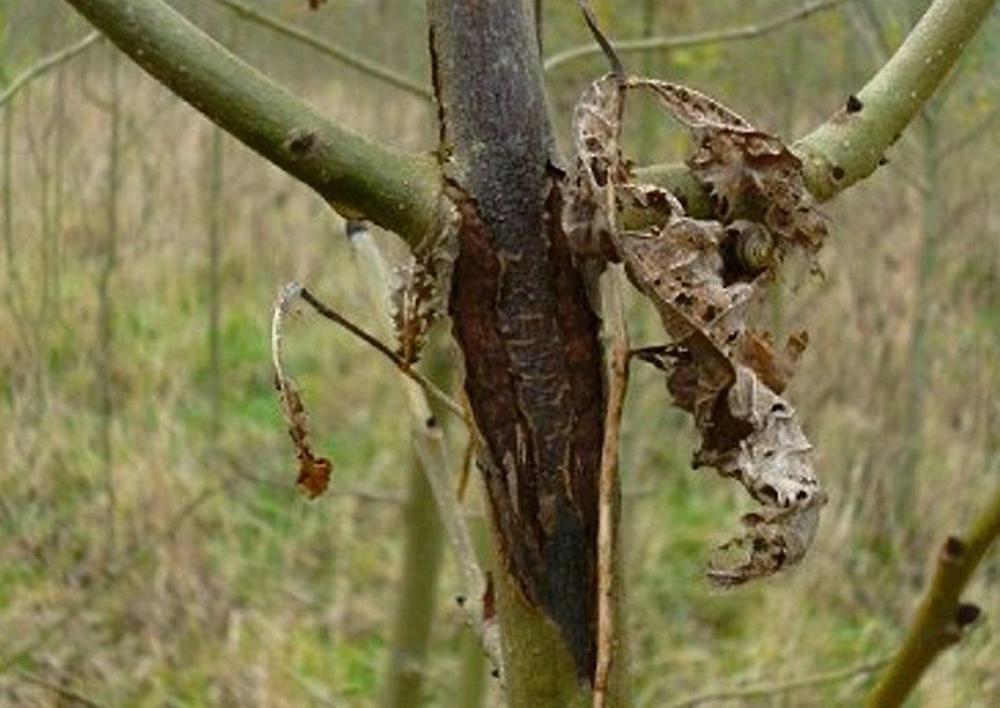
A list of all of the pests & diseases that can affect trees in the UK is long and potentially alarming; fortunately, most of us not directly involved in tree and woodland care will generally come across only a few. Some, however, can prove to be devastating: Dutch Elm Disease killed tens of millions of mature trees in the 1970s, almost wiping out what was one of the dominant species across much of Britain and thereby transforming the landscape. Chalara Ash Dieback (illustrated on the left) is currently sweeping through the country and has a similar capacity to alter our landscapes. However, unlike English elms, which largely reproduced by suckers and so had very little genetic vaiability , Ash trees reproduce sexually. As a result, individual individuals ash trees are much more variable and there will be a proportion of trees that show a degree of resistance to the disease. It is certain that many thousands of ash trees will die, but it is to be hoped that a residual population of resistant trees will survive to eventually repopulate the countryside.
Below is a link to a list of tree pests & diseases and another showing which diseases tree species are most likey to suffer from. More detailed information on some of the more prevalent ailments follow on further down this page.
FInd out about WOOD DECAY FUNGI by clicking the button on the right.

Acute Oak Decline (AOD)
In the UK, thousands of oak trees are “bleeding,” oozing dark liquid from cracks on their bark. What lies underneath are fluid-filled necrotic cavities that disrupts their life force by impeding the normal flow of nutrients and water. Taking advantage of the weakened state of the trees, are bark-boring beetles, which lay their eggs in the cracks of the bark. These are the characteristic signs of Acute Oak Decline, a disease that can kill a tree within four or five years of symptom onset.
The disease is found mostly on mature oak trees, but younger trees can also be affected. It is a complex infection and seems to be caused by the combined effects of at least two species of bacteria. For infection to occur, it is likely the trees need to be weakened (predisposed) by certain factors, especially environmental factors.
Symptoms include the dark staining of the bark of infected trees and frequently, the presence of the D-shaped exit holes made by the emerging beetles. The tree canopy is likely to thin as the tree nears death, which can take some time although symptoms can develop rapidly over 18 months. Suspected sightings can be reported to Tree Alert.
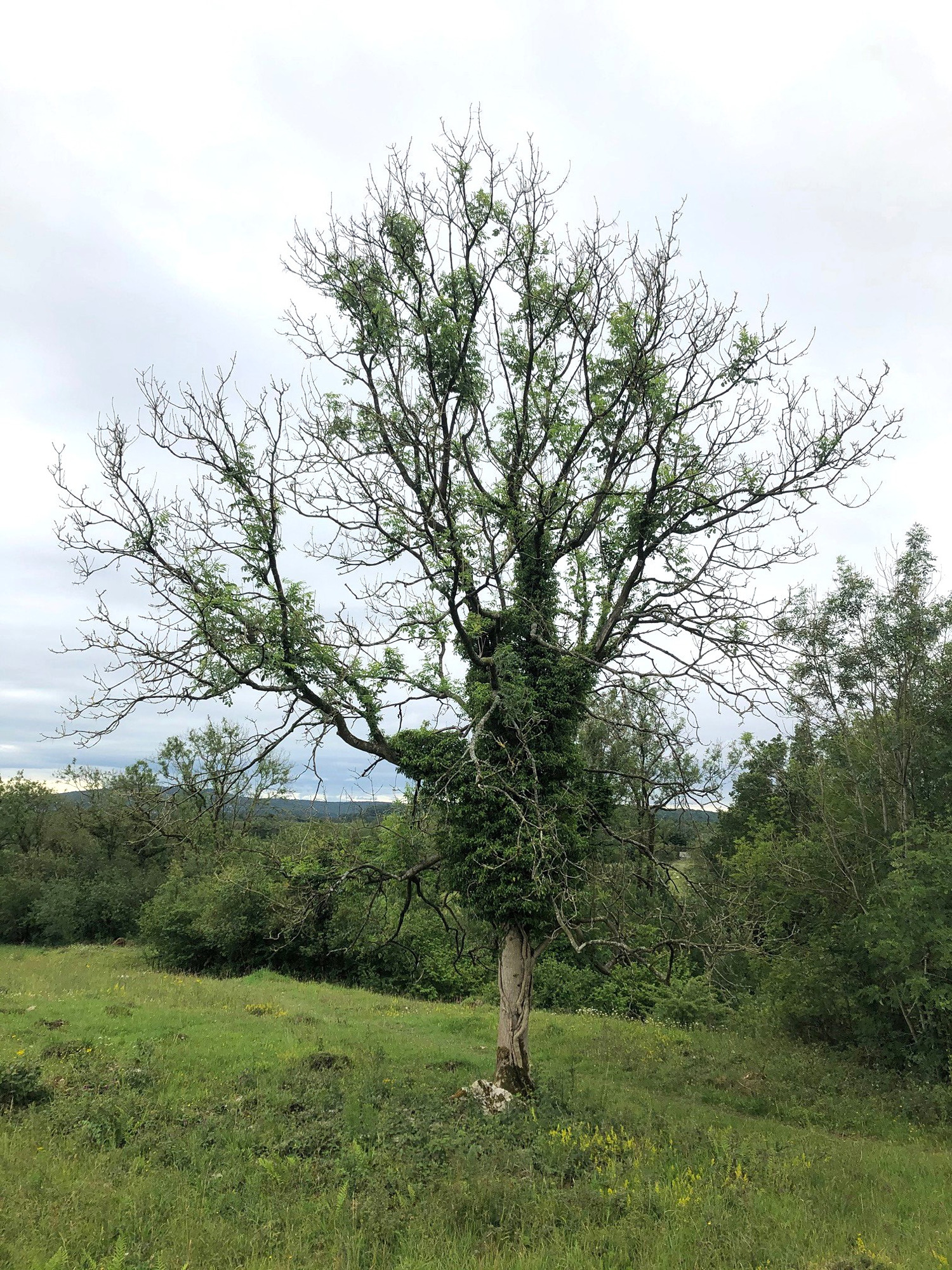
Ash Dieback (Hymenoscyphus fraxineus)
Chalara ash dieback is caused by the fungus Hymenoscyphus fraxineus and is a serious fungal disease affecting ash trees. It was officially detected in the UK in 2012 and is now widespread. The fungus causes gradual crown dieback and can also attack the root collar of susceptible trees.Depending on site conditions and the genetic make-up of the tree, a susceptible mature ash may take several years to decline and die; on the other hand small saplings may die within a single season.
Ash trees are an important and significant tree in the landscape, both rural and urban. They provide valuable habitat for a range of wildlife both within woodlands and along corridors such as hedgerows and roadsides. Healthy trees are important to farm businesses and nature, providing shelterbelts, reducing run-off and soil erosion. To give the species the best chance of surviving and re-populating the country side, it is vital that healthy trees are retained: pre-emptive felling of non-symptomatic trees should be avoided. However, infected trees may pose a safety risk to person and property, particualry where they are close to busy roads, public areas or other high-use areas and in such cases safety must be a primary concern. Click links below for further details on management and recognition of the disease.

Beech Bark Disease (Nectria coccinea var. faginata and Nectria galligena)
Beech Bark Disease is the result of an interaction between the Beech Scale insect (also known as Felted Beech Coccus - see entry below under 'Scale Insects') and Nectria species of fungus. While the scale insects themselves cause little significant harm, by piercing the bark to feed on the sap they provide an opportunity for the fungus to gain entry and colonise the tree's tissues. Initially the fungus can result in small blackish spots on the bark that exude a sticky liquid. Each spot indicates a small area of dead or dying bark which can result in small pits developing as the surrounding tissue coninues to grows. Later, Nectria fungal fruiting bodies appear as pinhead sized red pimples; these may be scattered or in small groups but can also develop over large areas of bark, leading to larger lesions with the bark cracking; in severe cases areas of bark may become detached and fall away. The crowns of severely infected trees appear thin and yellowish; ultimately the disease can result in the death of the tree.
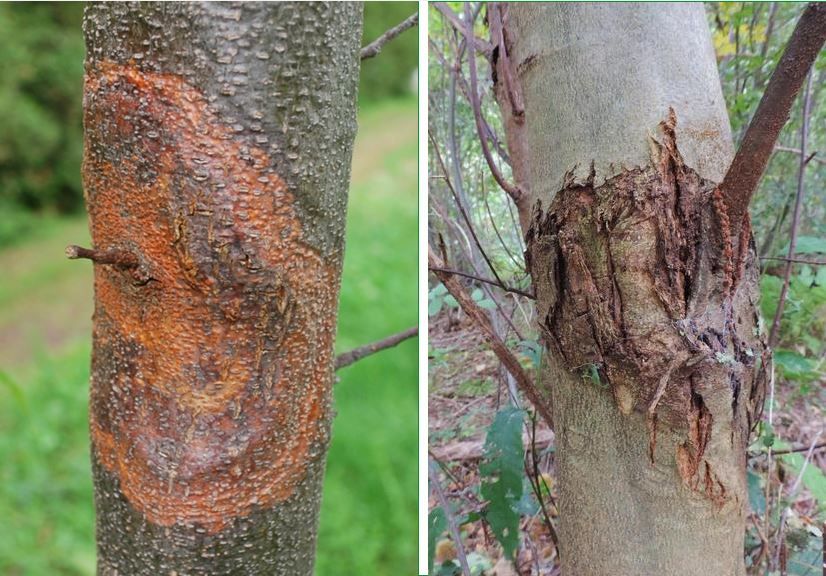
Chestnut Blight (Cryphonectria parasitica)
Sweet chestnut blight is a destructive disease of sweet chestnut trees (trees in the Castanea genus) caused by the ascomycete fungus Cryphonectria parasitica. It was formerly known as Endothia parasitica. It can also affect a few other plant species.
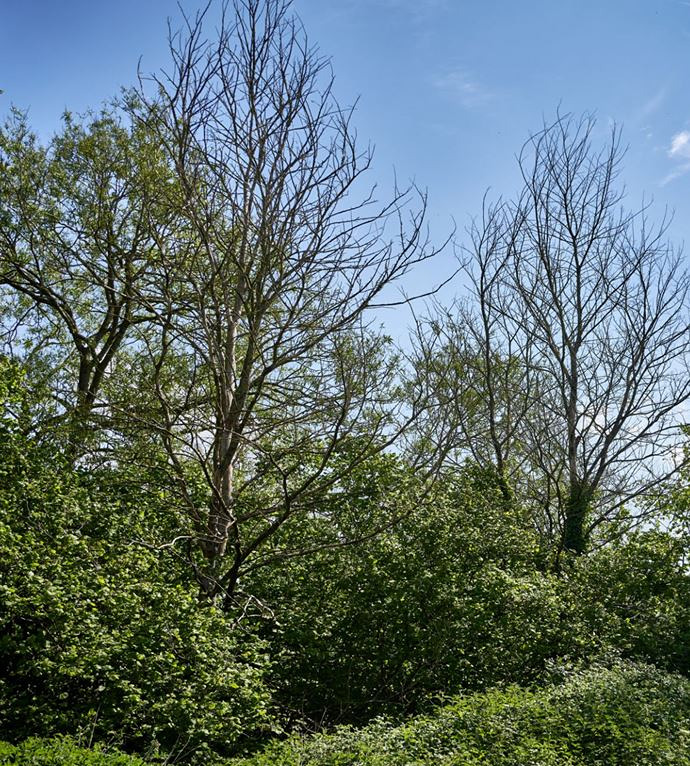
Dutch Elm Disease (Ophiostoma novo-ulmi)
Dutch elm disease* is fungal infection spread by a bark beetle, Scolytus scolytus (or S. multistriatus). A particularly virulent strain of the fungus was carried by beetles brought into the UK in timber brought from Canada in the 1960s. It quickly spread resulting in the death of millions of trees, including virtually all the mature English Elms in Herefordshire. The reason that the disease was so devastating was the fact that the English elm rarely, if ever, sets viable seed in Britain and reproduces by means of coppice shoots
and root suckers. As a result, all the trees were effectively clones, with identical genetic makeup and all highly susceptible to the disease.
For more information about the disease follow the links below
*Note: It became known as Dutch elm disease only because the fungus was first identified in Holland.]
Elm persistence & resistance:
Trees apparently killed by DED often retain viable roots and these frequently re-shoot. This new growth is also susceptible to the disease but is not reinfected until it has developed to a stage when its bark has become thick enough for the beetle to lay its eggs and the larvae to feed they tend to be reinfected, which may take 10-20 years. As a result, English elm is still widespread in hedgerows, but only as small trees or as part of a trimmed hedgerow. However, the enormous English elms are probably a thing of the past, at least until a resistant variety arises that can replace them. Several such cultivars are being developed and some are available for planting.
Because elm is an important food source for butterflies, disease resistant elms have been promoted by the conservation charity Butterfly Conservation, which has a list of the main resistant cultivars currently available: see Disease Resistant Elms.
Honey Fungus (Armillaria sp.)
When a tree or shrubs dies quite suddenly for no apparent reason, one of the first possible causes to look for is Honey Fungus. This may not be straightforward however; the fungus is quite variable in appearance and the toadstools (equivalent to the flowers of a plant) are not present for much of the year while the fungus continues to act under ground or within the tree. For more detailed information, see below:
Horse Chestnut Bleeding Canker
Since the 1970s, Horse Chestnut trees have been seen to suffer from 'bleeding' with a sticky, dark brown or blackish exudation oozing from the trunks, often leaving brown staining. Understood to be caused by infection by a species of Phytophthora, a fungus-like organism, it was relaltively uncommon until in about 2000 the symptoms began to be seen much more frequently.This was eventually found to be associated with an infection by a bacterium, Pseudomonas syringae pv. aesculi, and by 2007 nearly half of the horse chestnuts in Britain were affected. The disease leads to areas of bark dying back; if the areas of dead bark extend right around the trunk the tree may die; frequently, however, the infection stabilises and new tissue may begin to grow over the dead areas. This may lead to some recovery, although often the trunk is left somewhat distorted. However, secondary infections by fungi may lead to decay becoming established in the lesions which may become so extensive as to require the removal of branches or even the the felling of the tree. More information is available on the links below.
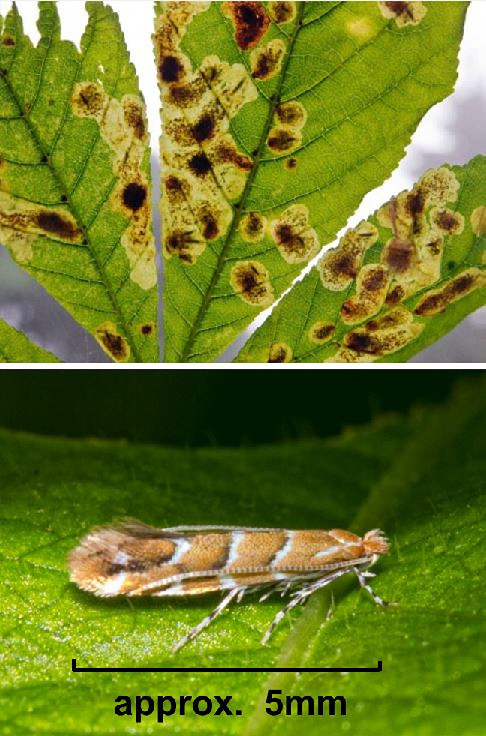
Horse Chestnut Leaf Miner (Cammeraria ohridella)
By late summer, the leaves of many horse chestnut trees can be seen to have developed brown blotches and in some cases turned brown throughout. In severe cases the entire crown turns brown, making it look like autumn in late summer. This is caused by the Horse Chestnut Leaf Miner (Cammeraria ohridella), a tiny moth that lays its eggs on the leaves of the horse chestnut; these then hatch out into larvae that eat the green tissues inside the leaves. The damage can be highly disfiguring and may cause sonme stunting of growth. However, as most of the tree's growth occurs in the spring and early summer, the more severe damage that developes in late summer has little effect on the tree's overall vitality. In fact, trees survive repeated infestations and come into leaf and flower normally in subsequent years and the felling of infected trees is therefore unnecessary. Furthermore, because the insects are now well established across the countryn, the removal of infected trees trees have any effect on the frequency and spread of the disease as .
Horse chestnuts have been grown in Britain since the late 16th century but it originated in south-eastern Europe. No doubt leaf-mining insects had been feeding on these native trees for many years, it was only in 1986 that Cammeraria ohridella was first identified. First recorded in the Balkans, it spread rapidly across Europe, infecting the many millions of chestnut trees that had been introduced as an ornamental species. The moth reached England in 2002, since when it has spread throughout the country.
Control: Perhaps the most significant means of limiting the spread of the insect is to sweep up and dispose of fallen leaves by composting, burning or other means. Pestcide application is not to be advised: infestations do not threaten the viability of the tree and the probably side effects of insecticide application cannot be justified. Some natural control may develop in time as our native species learn that the vast numbers of larvae that develop over the summer months represent a valuanle food source. Blue and great tits have been already observed feeding on the larvae, although as yet they have made little impact on the population as a whole. Certain wasps parasitize the larvae, although once again they have not as yet proved significant in controlling overall numbers.
More information is available on the following links:-
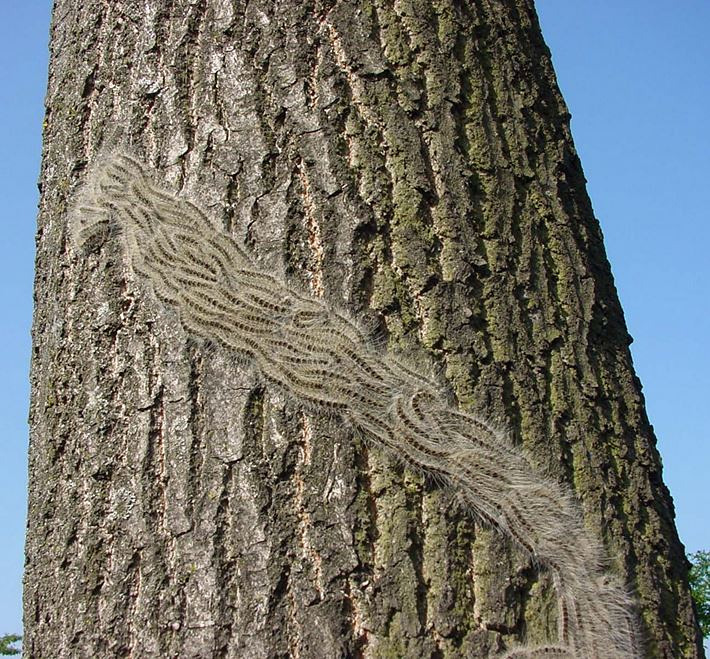
Oak Processionary Moth
(Thaumetopoea processionea)
The caterpillars of the oak processionary moth (OPM) are pests of oak trees where they feed on the leaves. Large populations can strip whole oak trees bare, leaving them more vulnerable to other pests and diseases. However, when disturbed the caterpillars release tiny hairs which can cause a serious reaction including a itching rash, eye irrirtaions sore thorats and breathing difficulties. Bceause of the risk to human health it is a notifiable pest which should be reported using the Tree Alert website or by emailing [email protected]
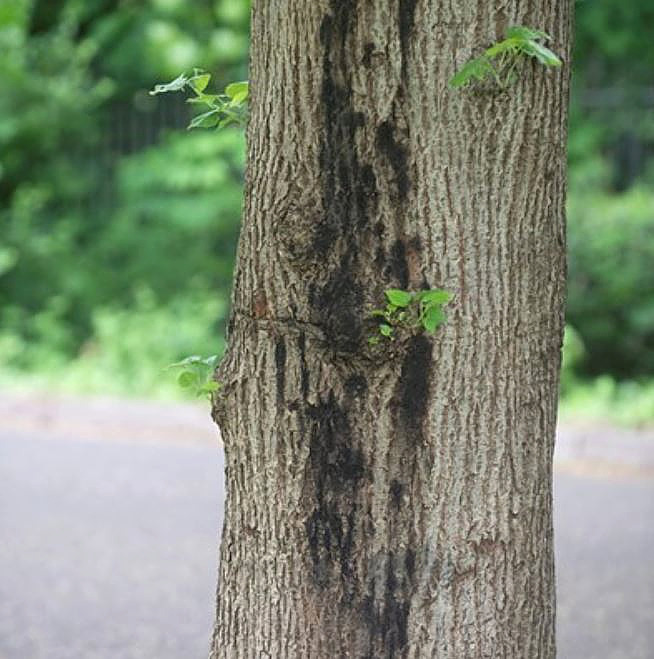
Phytophthora Bleeding Canker
Bleeding canker is a term for a number of tree diseases that result in dark, sticky fuid oozing from the bark of trees, staining the bark which, if cut away over infected areas, will reveal a reddish-brown discoloured area of tissue. The foliage of affected trees may be pale and sparse and branches may start to die back. Eventually the branch may die and in severe cases the whole tree may succumb. Many of the cankers seen in trees are the result of infection by one or more of any of the large number of species of Phytophthora For instance, the bleeding cankers seen on lime trees (Tilia spp. as illustrated above) are associated with P. cactorum and P. plurivora; these and other species of Phytophthora can occur on a range of trees including Beech, Maples (including sycamore), Oak and Birch. See the entry below for other phytophthora diseases.
NOTE - Horse Chestnut Bleeding Canker, which is caused by a bacterium, is dealt with in a separate entry above.)
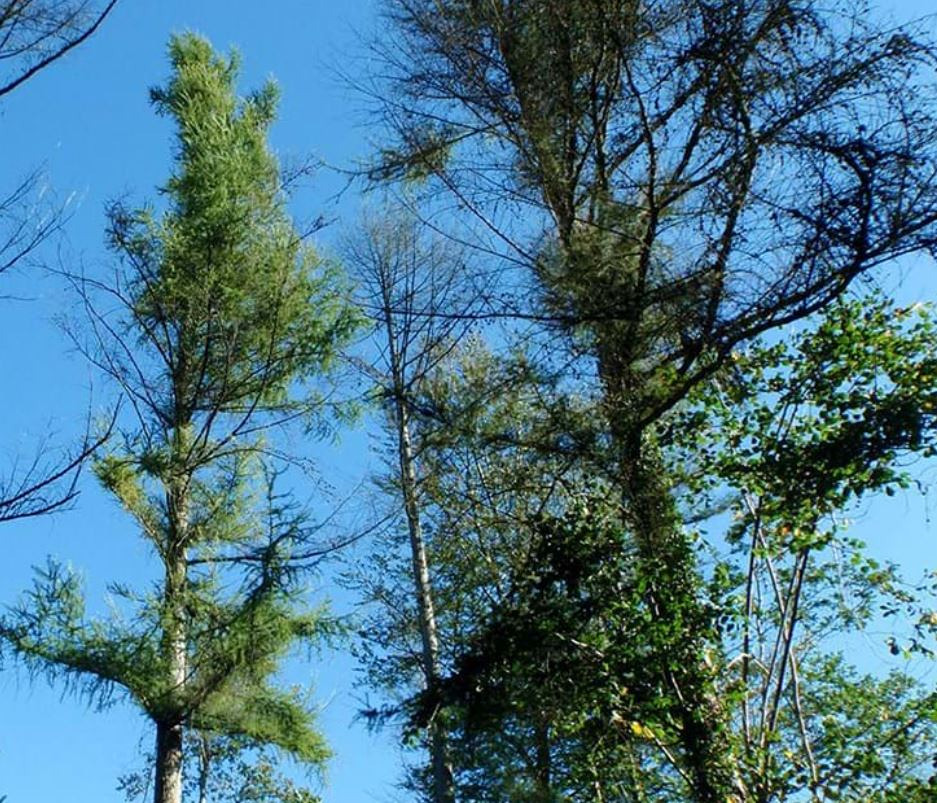
Phytophthora diseases (including Ramorum disease)
Phytophthora is a group of 'water moulds', microorganisms which, although fungus-like, are actually related to diatoms and brown algae. There are over 100 different species and are responsible for a wide range of diseases causing extensive damage and death to more than 150 plant species, many of great ecominic andsocial significance. (Potato blight caused by P. infestans led to the Irish Potato Famine that killed about 1,000,000 people).
Phytophthora ramorum causes the death of a wide range of trees including Sweet Chestnut and Oak but its greatest impact so far has been on larch plantations, leading to thousands of hectares of felling around the UK. Suspected cases of ramorum disease on trees or other woodland plants must be reported to the forestry authorities. If you think you have seen ramorum disease on a tree or other forest or woodland plant, please check the guide to identification and symptoms in our Phytophthora manual before making your report.
Other species of Phytophthora are also significant: Phytophthora alni is largely specific to Alder trees and has led to the death of many trees. (See link below.) It is thought that up to a third of British alder trees may be affected, with heavy tree losses are also occurring in alder populations in the borders’ region of Wales, including Herefordshire. Phytophthora lateralis attacks Lawson cypress, as well as juniper and western red-cedar. Holly (trees and hedges)have their own species, Phytophthora ilicis which causes Holly Leaf Blight, characterised by dark blotches on the leaves which then drop prematurely. In hedges it can result in ‘arches’ of defoliation, where the damaged area is widest near the ground. Unfortunately the storey doesn't end there as there are many other trees, shrubs and other plants that can be affected by one or other of the various species of Phytophthora. Click here for an RHS publication that provides a list of plants showing susceptibility or some dgeree of resistance to root rot.
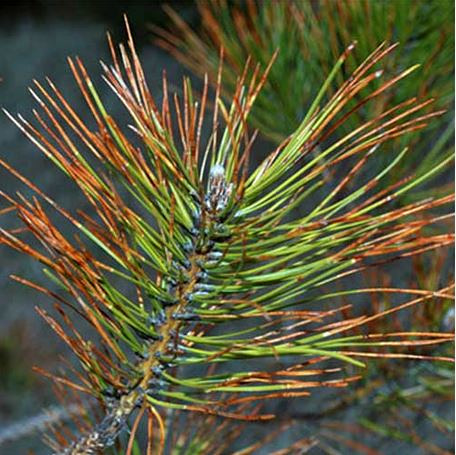
Red Band Needle Blight of Pine (Dothistroma septosporum)
Known as red band needle blight because of the colourful symptoms it shows. It causes premature needle defoliation, resulting in loss of timber yield and, in severe cases, tree death. A disease of conifer trees and pines in particular which, within the forestry industry, is economically important.
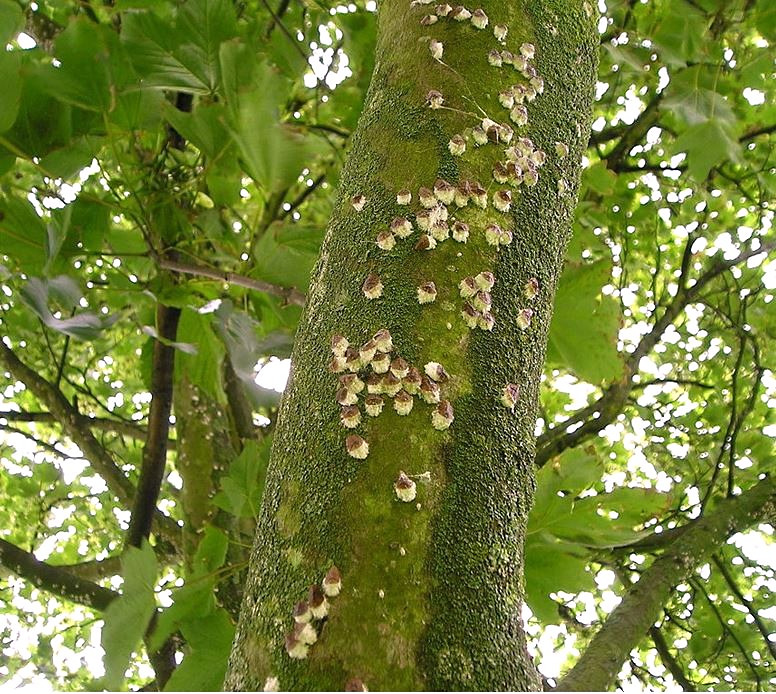
Scale Insects
Scale insects are sap-feeders and take a mulitude of forms, most of which show little remblance to what one usually thinks of as an insect. Perhaps those most commonly found that affect trees are Horse Chestnut scale (Pulvinaria regalis) and Beech scale, otherwise known as Felted Beech Coccus (Cryptococcus fagisuga).
Horse Chestnut Scale insect (Pulvinaria regalis) despite its name is frequently found on a variety of other species of tree, notably on Lime (Tilia spp.) Sycamore (Acer pseudoplatanus) and other maples. The insects are sap feeders and the females (the males are rarely seen) produce small domed scales that look rather like small limpets attached to the bark of the trees which serve to protectin the insects' otherwise soft, often limbless bodies. Although they are found in a variety of habitats, they seem to affect urban trees more commonly than rural trees.
Their sap-sucking can reduce the host tree's vigour but they aren't regarded as significantly harmful to the host trees. Large infestations can be unsightly and may cause nuisance as a result of the production of sticky honeydew, which in turn may develop a sooty mould.

Beech scale or Felted Beech Coccus (Cryptococcus fagisuga). This species affects beech trees but unlike the 'true' scale that protects Pulvinaria, 'Beech Scale' insects protect themselves by extruding a covering of woolly, white, waxy material, hence the more discriptive name 'Felted Beech Coccus'. It appears as a dirty white deposit on the bark of beech trees and is itself is essentially benign inasmuch as it does littel diect harm to the host tree. However, it is associated with the more serious Beech Bark Disease (see entry above).
